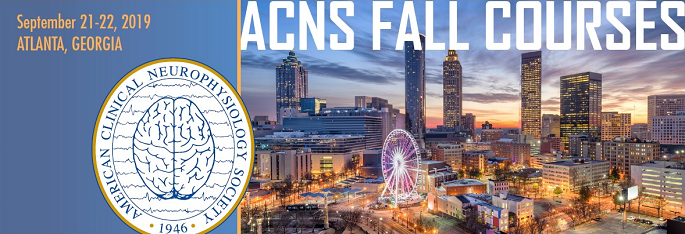- About ACNS
- Meetings
- Education
- Practice
- Research
- Advocacy
- Membership

Claim CME and Attendance Certificates
The 2019 Fall Courses are designed around new and rapidly-evolving areas of clinical neurophysiology. Educational activities will cover both basic methodologies, and innovative techniques.
The Society’s educational activities are directed to clinical neurophysiologists, neurologists, psychiatrists, physiatrists, neurosurgeons, trainees in these disciplines and other physicians and researchers who utilize clinical neurophysiologic techniques and knowledge in the diagnosis and management of patients with disorders of the peripheral and central nervous system.
Intensive Care Unit EEG Monitoring (ICU EEG)
At the conclusion of this course, participants should be able to:
Neurophysiologic Intraoperative Monitoring (NIOM)
At the conclusion of this course, participants should be able to:
Stereo-Encephalography (Stereo EEG)
At the conclusion of this course, the participant should be able to:
Neonatal and Pediatric EEG Symposium - Basic Principles and Advanced Concepts
At the conclusion of this course, participants should be able to:
CPT Coding Changes: EEG Monitoring and Neurostimulation
Information coming soon.
This activity has been planned and implemented in accordance with the Essential Areas and Policies of the Accreditation Council for Continuing Medical Education (ACCME) through the sponsorship of ACNS. ACNS is accredited by the ACCME to provide continuing medical education for physicians.
ACNS designates the Fall Courses for the maximum number of AMA PRA Category 1 Credit(s)™ indicated below:
Intensive Care Unit EEG Monitoring (ICU EEG) - Part. I: 6 AMA PRA Category 1 Credits™
Intensive Care Unit EEG Monitoring (ICU EEG) - Part. II: 6 AMA PRA Category 1 Credits™
Neurologic Intraoperative Monitoring (NIOM) - Part. I: 6 AMA PRA Category 1 Credits™
Neurologic Intraoperative Monitoring (NIOM) - Part. II: 6 AMA PRA Category 1 Credits™
Stereo-Electroencephalography (Stereo EEG) - Part. I: 2 AMA PRA Category 1 Credits™
Stereo-Electroencephalography (Stereo EEG) - Part. II: 2 AMA PRA Category 1 Credits™
Neonatal and Pediatric EEG Symposium: 2 AMA PRA Category 1 Credits™
CPT Coding Changes: 1.75 AMA PRA Category 1 Credits™